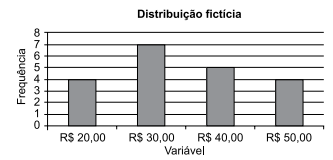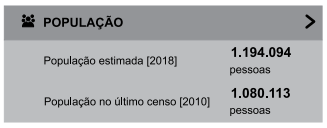Questões de Concurso
Comentadas para unicamp
Foram encontradas 553 questões
Resolva questões gratuitamente!
Junte-se a mais de 4 milhões de concurseiros!
1. What is an analog-digital converter?
An Analog-Digital Converter (ADC) is a widely used electronic component that converts an analog electric signal (usually a voltage) into a digital representation. The ADCs are at the front-end of any digital circuit that needs to process signals coming from the exterior world. Its schematic symbol is:

The output of a microphone, the voltage at a photodiode or the signal of an accelerometer are examples of analog values that need to be converted so that a microprocessor can work with them.
2. How does the ADC convert a signal?
Many ways have been developed to convert an analog signal, each with its strengths and weaknesses. The choice of the ADC for a given application is usually defined by the requirements you have: if you need speed, use a fast ADC; if you need precision, use an accurate ADC; if you are constrained in space, use a compact ADC.
All ADCs work under the same principle: they need to convert a signal to a certain number of bits N. The sequence of bits represents the number and each bit has the double of the weight of the next, starting from the Most Significant Bit (MSB) up to the Least Significant Bit (LSB). In a nutshell, we want to find the sequence of bits bN−1, bN−2, ..., b0 that represents the analog value Vin as Vin=∑n=0N−1bn2nVref2N.
(www.onmyphd.com/?p=analog.digital.converter. Adaptado)
1. What is an analog-digital converter?
An Analog-Digital Converter (ADC) is a widely used electronic component that converts an analog electric signal (usually a voltage) into a digital representation. The ADCs are at the front-end of any digital circuit that needs to process signals coming from the exterior world. Its schematic symbol is:

The output of a microphone, the voltage at a photodiode or the signal of an accelerometer are examples of analog values that need to be converted so that a microprocessor can work with them.
2. How does the ADC convert a signal?
Many ways have been developed to convert an analog signal, each with its strengths and weaknesses. The choice of the ADC for a given application is usually defined by the requirements you have: if you need speed, use a fast ADC; if you need precision, use an accurate ADC; if you are constrained in space, use a compact ADC.
All ADCs work under the same principle: they need to convert a signal to a certain number of bits N. The sequence of bits represents the number and each bit has the double of the weight of the next, starting from the Most Significant Bit (MSB) up to the Least Significant Bit (LSB). In a nutshell, we want to find the sequence of bits bN−1, bN−2, ..., b0 that represents the analog value Vin as Vin=∑n=0N−1bn2nVref2N.
(www.onmyphd.com/?p=analog.digital.converter. Adaptado)
1. What is an analog-digital converter?
An Analog-Digital Converter (ADC) is a widely used electronic component that converts an analog electric signal (usually a voltage) into a digital representation. The ADCs are at the front-end of any digital circuit that needs to process signals coming from the exterior world. Its schematic symbol is:

The output of a microphone, the voltage at a photodiode or the signal of an accelerometer are examples of analog values that need to be converted so that a microprocessor can work with them.
2. How does the ADC convert a signal?
Many ways have been developed to convert an analog signal, each with its strengths and weaknesses. The choice of the ADC for a given application is usually defined by the requirements you have: if you need speed, use a fast ADC; if you need precision, use an accurate ADC; if you are constrained in space, use a compact ADC.
All ADCs work under the same principle: they need to convert a signal to a certain number of bits N. The sequence of bits represents the number and each bit has the double of the weight of the next, starting from the Most Significant Bit (MSB) up to the Least Significant Bit (LSB). In a nutshell, we want to find the sequence of bits bN−1, bN−2, ..., b0 that represents the analog value Vin as Vin=∑n=0N−1bn2nVref2N.
(www.onmyphd.com/?p=analog.digital.converter. Adaptado)
1. What is an analog-digital converter?
An Analog-Digital Converter (ADC) is a widely used electronic component that converts an analog electric signal (usually a voltage) into a digital representation. The ADCs are at the front-end of any digital circuit that needs to process signals coming from the exterior world. Its schematic symbol is:

The output of a microphone, the voltage at a photodiode or the signal of an accelerometer are examples of analog values that need to be converted so that a microprocessor can work with them.
2. How does the ADC convert a signal?
Many ways have been developed to convert an analog signal, each with its strengths and weaknesses. The choice of the ADC for a given application is usually defined by the requirements you have: if you need speed, use a fast ADC; if you need precision, use an accurate ADC; if you are constrained in space, use a compact ADC.
All ADCs work under the same principle: they need to convert a signal to a certain number of bits N. The sequence of bits represents the number and each bit has the double of the weight of the next, starting from the Most Significant Bit (MSB) up to the Least Significant Bit (LSB). In a nutshell, we want to find the sequence of bits bN−1, bN−2, ..., b0 that represents the analog value Vin as Vin=∑n=0N−1bn2nVref2N.
(www.onmyphd.com/?p=analog.digital.converter. Adaptado)
Considere as informações do gráfico.

Com base nas informações apresentadas no gráfico, é
correto afirmar que
Um reservatório com formato interno de paralelepípedo reto retangular, com 3 metros de altura, está com 12,6 m3 de água, o que corresponde a três quintos do seu volume máximo. Sabendo-se que a diferença entre as medidas das arestas da base desse reservatório é de 1,5 metro, é correto afirmar que o perímetro da base desse reservatório mede
Considere a seguinte informação, apresentada pela Companhia Nacional de Abastecimento (Conab), em 20 de novembro de 2018.
“O aumento no preço do tomate foi o grande destaque na análise das hortaliças nas principais Centrais de Abastecimento (Ceasas) do país. Desta vez, a elevação foi unânime e teve percentuais significativos, com maior alta de 145%, em Vitória (ES), seguida de 127% em Goiânia (GO) e 105% em Belo Horizonte (MG).”
(https://www.conab.gov.br/ultimas-noticias/2579-boletim-prohort-mostra-que-tomate-e-a-hortalica-com-maior-alta-de-precos)
Supondo que em Vitória, após essa informação, o tomate estivesse sendo vendido ao preço de R$ 3,92, é correto afirmar que, nesse preço, com base na informação dada, estaria embutido um aumentado de
Considere as informações a seguir, apresentadas pelo Instituto Brasileiro de Geografia e Estatística (IBGE), sobre a cidade de Campinas.

Com base nas informações apresentadas, é correto afirmar que a população estimada, em 2018, comparada
com a população identificada no censo de 2010, cresceu
em, aproximadamente,
Página infeliz
O mercado editorial no Brasil nunca pareceu tão próximo de uma catástrofe – com as duas principais redes de livrarias do país, Saraiva e Cultura, em uma crise profunda, reduzindo o número de lojas e com dívidas que parecem sem fim.
Líder do mercado, a Saraiva, que já acumula atrasos de pagamentos a editores nos últimos anos, anunciou nesta semana o fechamento de 20 lojas. Em nota, a rede afirma que a medida tem a ver com “desafios econômicos e operacionais”, além de uma mudança na “dinâmica do varejo”.
Na semana anterior, a Livraria Cultura entrou em recuperação judicial. No pedido à Justiça, a rede afirma acumular prejuízos nos últimos quatro anos, ter custos que só crescem e vendas menores. Mesmo assim, diz a petição enviada ao juiz, não teria aumentado seus preços.
O enrosco da Cultura está explicado aí. Diante da crise, a empresa passou a pegar dinheiro emprestado com os bancos – o tamanho da dívida é de R$ 63 milhões.
Com os atrasos nos pagamentos das duas redes, editoras já promoveram uma série de demissões ao longo dos últimos dois anos.
O cenário de derrocada, contudo, parece estar em descompasso com os números de vendas. Desde o começo do ano, os dados compilados pela Nielsen, empresa de pesquisa de mercado, levantados a pedido do Sindicato Nacional dos Editores de Livros, mostravam que o meio livreiro vinha dando sinais de melhoras pela primeira vez, desde o início da recessão econômica que abala o país.
Simone Paulino, da Nós, editora independente de São Paulo, enxerga um descompasso entre as vendas em alta e a crise. Nas palavras dela, “um paradoxo assustador.” A editora nunca vendeu tanto na Cultura quanto nesses últimos seis meses”, diz. E é justamente nesse período que eles não têm sido pagos.
“O modelo de produção do livro é muito complicado. Você investe desde a compra do direito autoral ou tradução e vai investindo ao longo de todo o processo. Na hora que você deveria receber, esse dinheiro não volta”, diz Paulino.
“Os grandes grupos têm uma estrutura de advogados que vão ter estratégia para tentar receber. E para os pequenos? O que vai acontecer?”
Mas há uma esperança para os editores do país: o preço fixo do livro. Diante do cenário de crise, a maior parte dos editores aposta em uma carta tirada da manga no apagar das luzes do atual governo – a criação, no país, do preço fixo do livro – norma a ser implantada por medida provisória – nos moldes de boa parte de países europeus, como França e Alemanha.
Os editores se inspiram no pujante mercado europeu. Por lá, o preço fixo existe desde 1837, quando a Dinamarca criou a sua lei limitando descontos, abolida só em 2001. A crença é a de que a crise atual é em parte causada pela guerra de preço. Unificar o valor de capa permitiria um florescimento das livrarias independentes, uma vez que elas competiriam de forma mais justa com as grandes redes.
(Folha de S. Paulo, 03.11.2018. Adaptado)
Considere as informações adaptadas de um ofício.

Considerando-se a interlocução estabelecida, as lacunas
do texto devem ser preenchidas, correta e respectivamente, com: